0001. 两数之和【简单】
- 📂 TNotes.yuque
- 1. 📝 Description
- 2. 💻 solutions.1 - 双指针暴力求解
- 3. 💻 solutions.2 - 静态哈希表
- 4. 💻 solutions.3 - 动态哈希表
1. 📝 Description
leetcode
给定一个整数数组 nums 和一个整数目标值 target,请你在该数组中找出 和为目标值 target 的那 两个 整数,并返回它们的数组下标。
你可以假设每种输入只会对应一个答案。但是,数组中同一个元素在答案里不能重复出现。你可以按任意顺序返回答案。
示例 1:
txt
输入:nums = [2,7,11,15], target = 9
输出:[0,1]
解释:因为 nums[0] + nums[1] == 9 ,返回 [0, 1] 。1
2
3
2
3
示例 2:
txt
输入:nums = [3,2,4], target = 6
输出:[1,2]1
2
2
示例 3:
txt
输入:nums = [3,3], target = 6
输出:[0,1]1
2
2
提示:
2 <= nums.length <= 10^4-10^9 <= nums[i] <= 10^9-10^9 <= target <= 10^9- 只会存在一个有效答案
进阶:你可以想出一个时间复杂度小于 O(n^2) 的算法吗?
2. 💻 solutions.1 - 双指针暴力求解


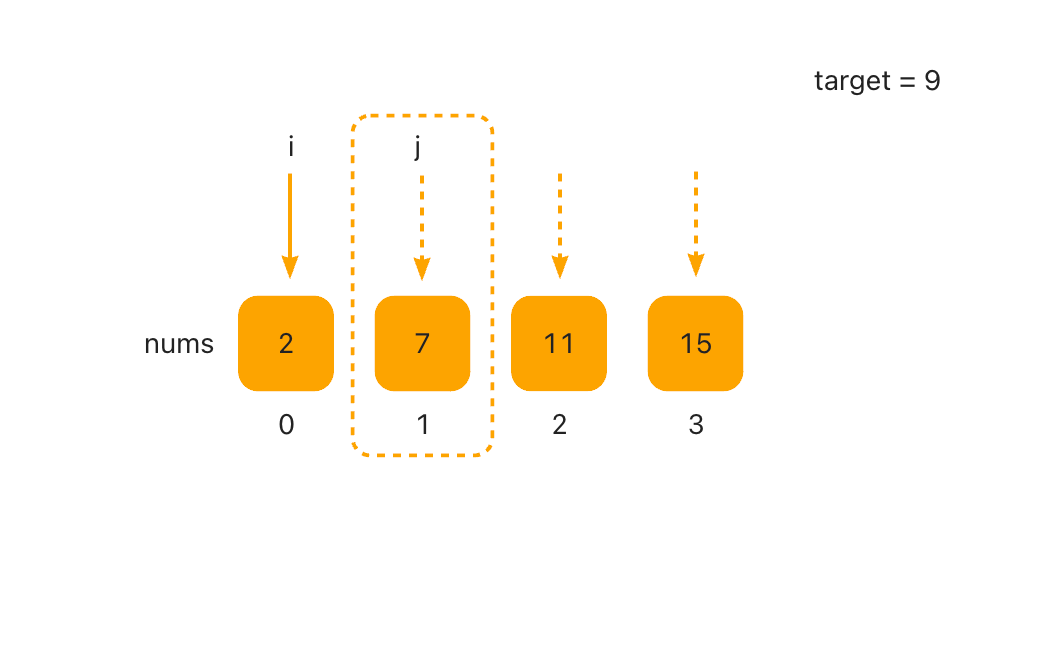
js
/**
* @param {number[]} nums
* @param {number} target
* @return {number[]}
*/
var twoSum = function (nums, target) {
for (let i = 0; i < nums.length - 1; i++)
for (let j = i + 1; j < nums.length; j++)
if (target === nums[j] + nums[i]) return [i, j]
}1
2
3
4
5
6
7
8
9
10
2
3
4
5
6
7
8
9
10
Details
- 时间复杂度:
- 空间复杂度:
- 这种方法的一个缺点是,当
n较大时,时间复杂度可能会变得非常高。 - 我们可以通过使用一种叫做哈希映射的数据结构来改进这个算法,这种数据结构可以在常数时间内完成查找操作,从而将算法的时间复杂度降低到
O(n)。但是,这将使空间复杂度增加到O(n),因为我们需要存储n个元素的哈希映射。
3. 💻 solutions.2 - 静态哈希表
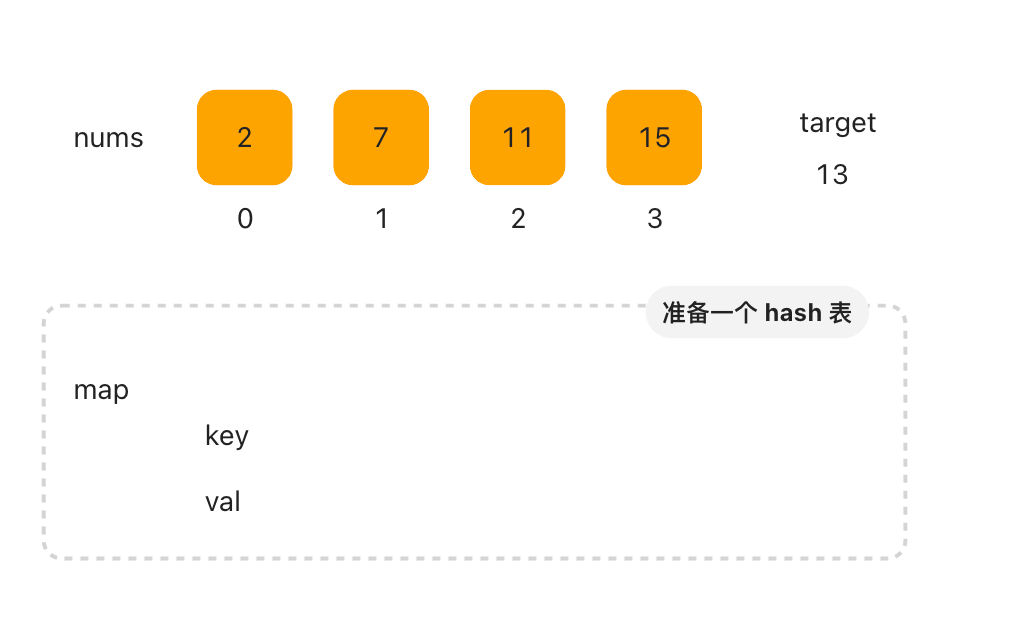
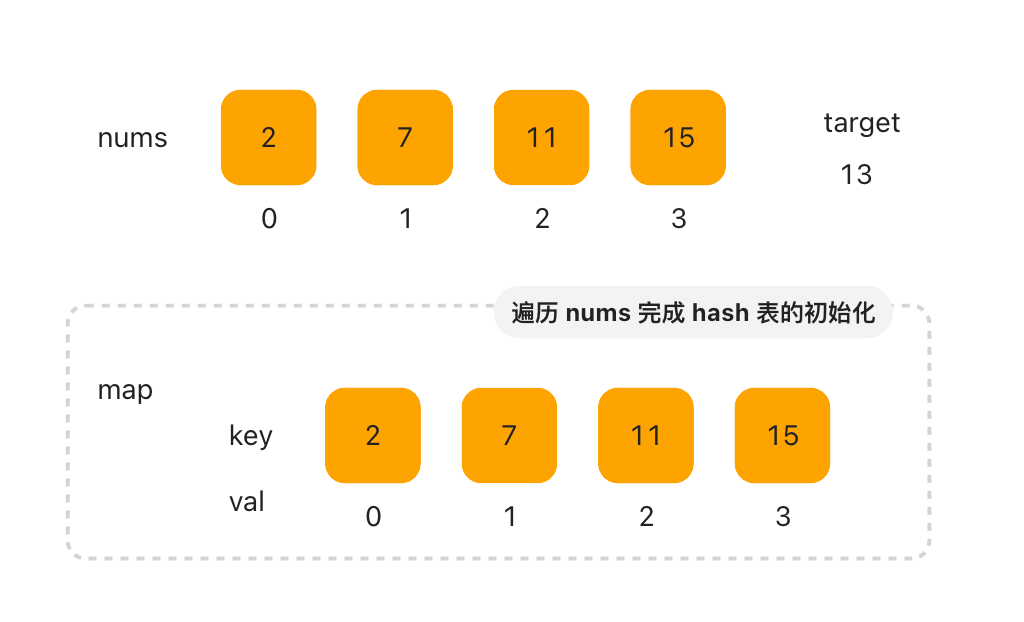
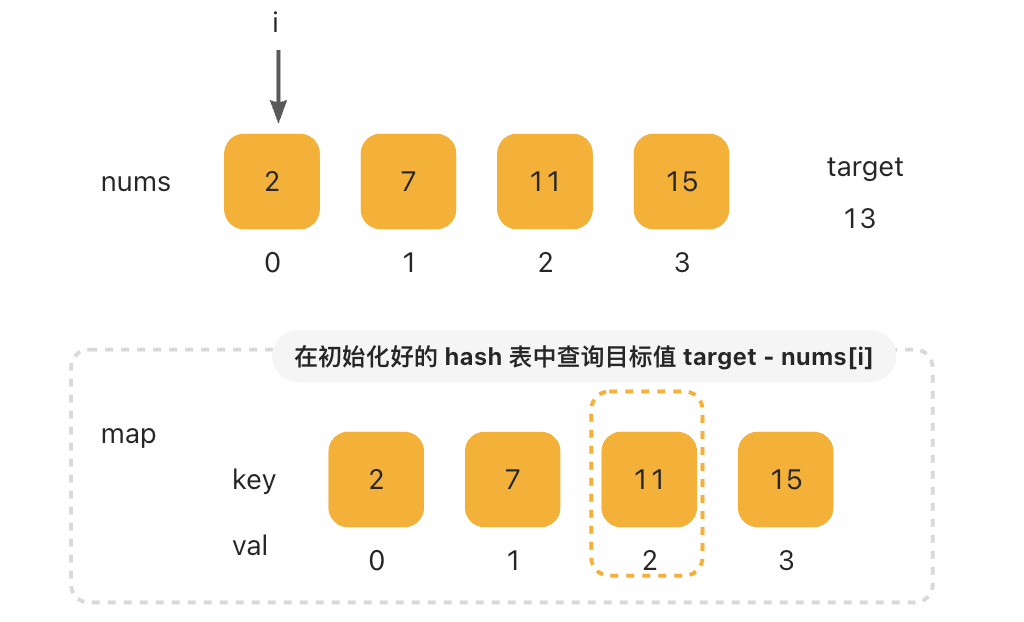
js
var twoSum = function (nums, target) {
// 初始化哈希表
const map = new Map()
for (let i = 0; i < nums.length; i++) map.set(nums[i], i)
// 查询哈希表
for (let i = 0; i < nums.length; i++) {
const anotherNum = target - nums[i]
if (map.has(anotherNum) && map.get(anotherNum) !== i)
return [i, map.get(anotherNum)]
}
}1
2
3
4
5
6
7
8
9
10
11
12
2
3
4
5
6
7
8
9
10
11
12
Details
- 时间复杂度:
- 空间复杂度:
- 基本流程:
- 【第一步】这种解法首先将数组中的每个元素及其索引添加到哈希表中
- 【第二步】然后在第二个循环中检查每个元素所对应的目标元素(即
target - nums[i])是否存在于哈希表中 - 注意,在查询的时候,该目标元素不能是
nums[i]本身(即map.get(anotherNum) !== i)
4. 💻 solutions.3 - 动态哈希表

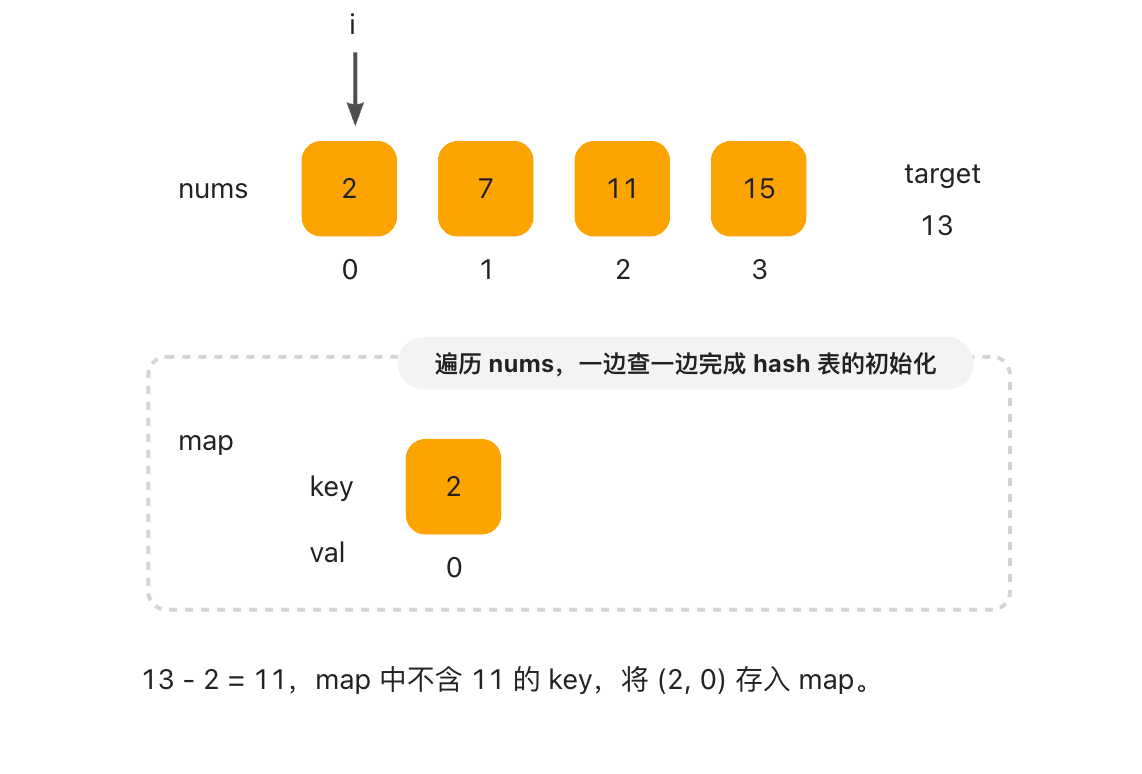
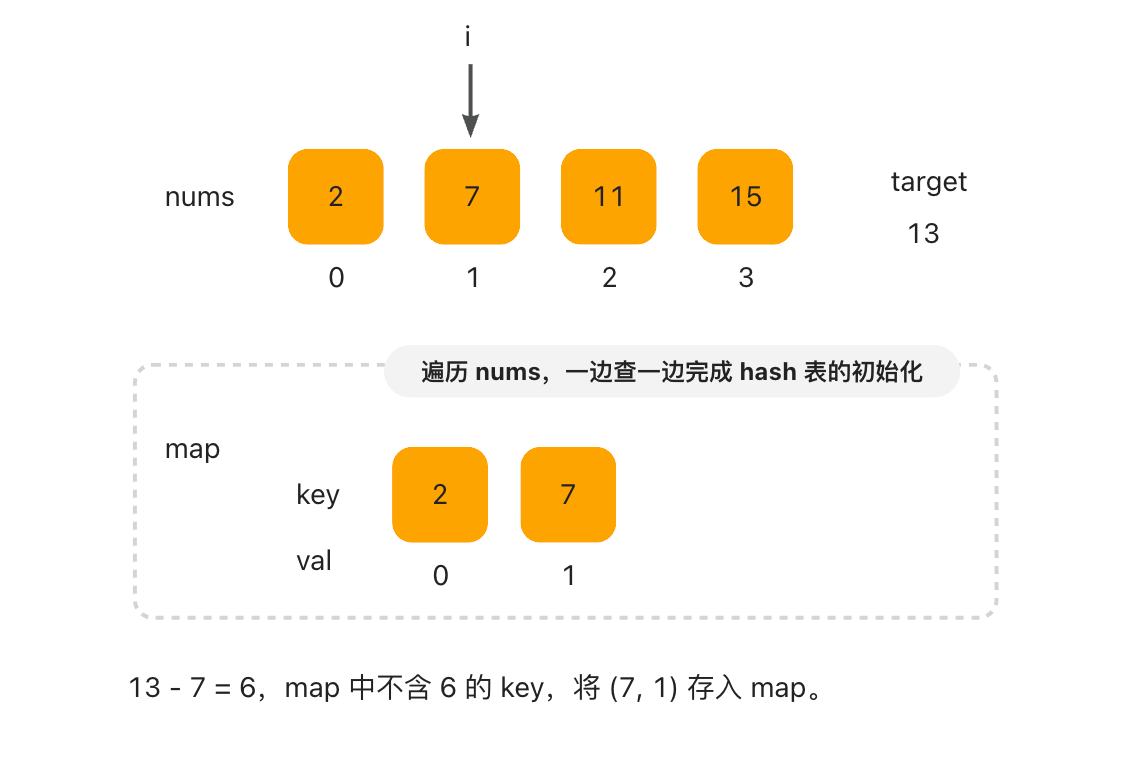
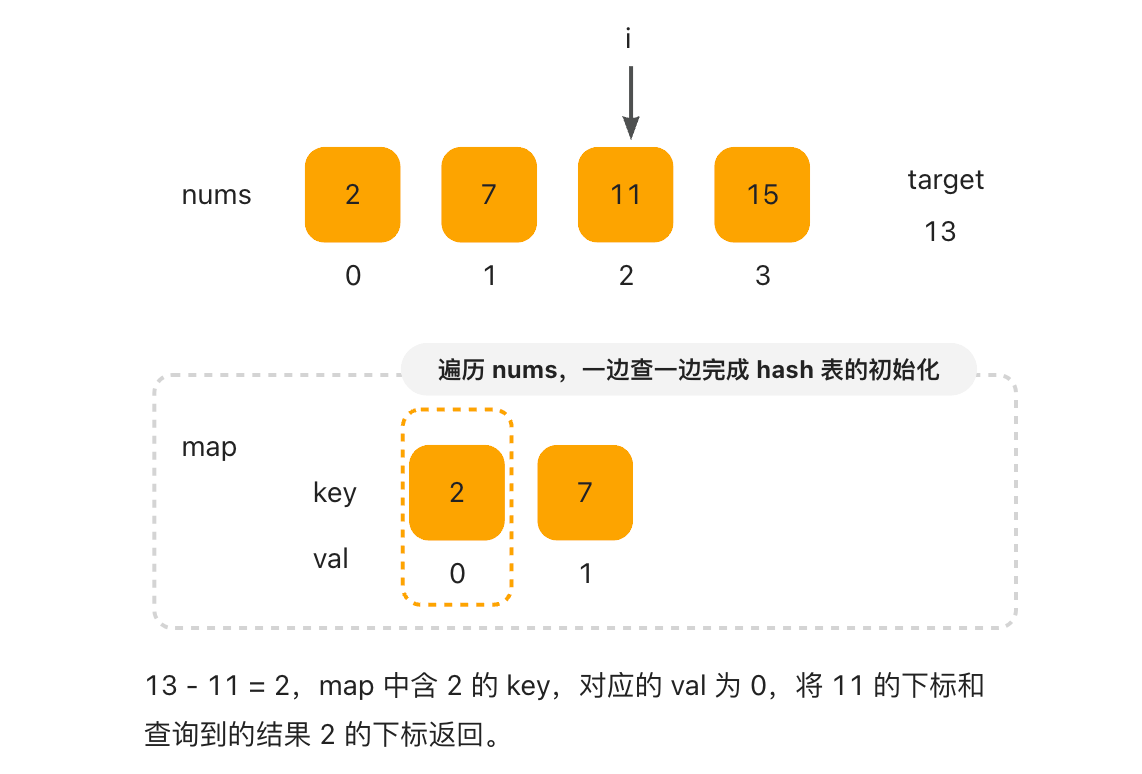
js
var twoSum = function (nums, target) {
const map = new Map();
for (let i = 0; i < nums.length; i++) {
const item = nums[i];
const anotherNum = target - item;
if (map.has(anotherNum)) {
return [i, map.get(anotherNum)];
}
map.set(item, i);
}
};1
2
3
4
5
6
7
8
9
10
11
2
3
4
5
6
7
8
9
10
11
ts
function twoSum(nums: number[], target: number): number[] {
const map: Map<number, number> = new Map();
for (let i = 0; i < nums.length; i++) {
const item = nums[i];
const anotherNum = target - item;
if (map.has(anotherNum)) {
return [i, map.get(anotherNum)!];
}
map.set(item, i);
}
return [];
}1
2
3
4
5
6
7
8
9
10
11
12
2
3
4
5
6
7
8
9
10
11
12
Details
- 时间复杂度:
- 空间复杂度:
- 每次在查的时候,都会将所有之前写入的值都查一边,不可能会存在遗漏的情况。任意俩数字组合,都只会被查一次。
- 🤔 在上述动态哈希表的题解中是“先查后写”,现在改写程序“先写后查”。比如在判断
map.has(anotherNum)之前执行map.set(item, i),请问这么做会出现什么问题?
- 事先明确一点,描述中提到“数组中同一个元素在答案里不能重复出现”。
- 思考这个问题时,不妨结合以下两个测试用例来辅助思考。
- 示例 2:
- 输入:nums = [3,2,4], target = 6
- 输出:[1,2]
- 示例 3:
- 输入:nums = [3,3], target = 6
- 输出:[0,1]
- 示例 2:
js
// 先写再查
var twoSum = function (nums, target) {
const map = new Map()
for (let i = 0; i < nums.length; i++) {
const item = nums[i]
map.set(item, i) // 写哈希表
const anotherNum = target - item
if (map.has(anotherNum)) {
// 查询
return [i, map.get(anotherNum)]
}
}
}
twoSum([3, 4, 2], 6) // [0, 0]
twoSum([3, 3], 6) // [0, 0]1
2
3
4
5
6
7
8
9
10
11
12
13
14
15
16
2
3
4
5
6
7
8
9
10
11
12
13
14
15
16
- 两次实际返回的结果都将是
[0, 0],因为第一个成员 3 刚被写入哈希表,立刻就被查了,所以返回了错误的结果。 - 每次查找,应该是去查其他成员,而非自身。如果先完成写操作,那么在查操作的时候,自身就会被查一边。
- 认识到问题之后,让我们来完善一下程序,加一条约束
map.get(anotherNum) !== i,防止查到的是自身是不是就 OK 了呢?
js
// 添加约束
var twoSum = function (nums, target) {
const map = new Map()
for (let i = 0; i < nums.length; i++) {
const item = nums[i]
map.set(item, i) // 写哈希表
const anotherNum = target - item
if (map.has(anotherNum) && map.get(anotherNum) !== i) {
// 查询
return [i, map.get(anotherNum)]
}
}
}
twoSum([3, 2, 3], 6) // undefined1
2
3
4
5
6
7
8
9
10
11
12
13
14
15
2
3
4
5
6
7
8
9
10
11
12
13
14
15
- 答案是依旧有问题,这种做法将会导致旧数据被覆盖。
- 在哈希表中,对于重复的 key 值,后面的会覆盖前面的。第一次存入的
3 => 0还没被查询,就被3 => 2给覆盖了,那你还查个 der。 - 小结:对比“静态”哈希表和“动态”哈希表之间的差异
- 静态:先把整个哈希表准备好,然后再查询。
- 动态:一边查询,一边构建哈希表。